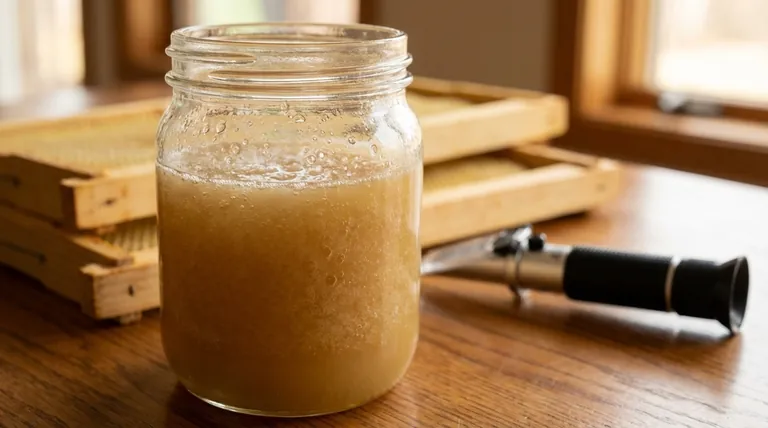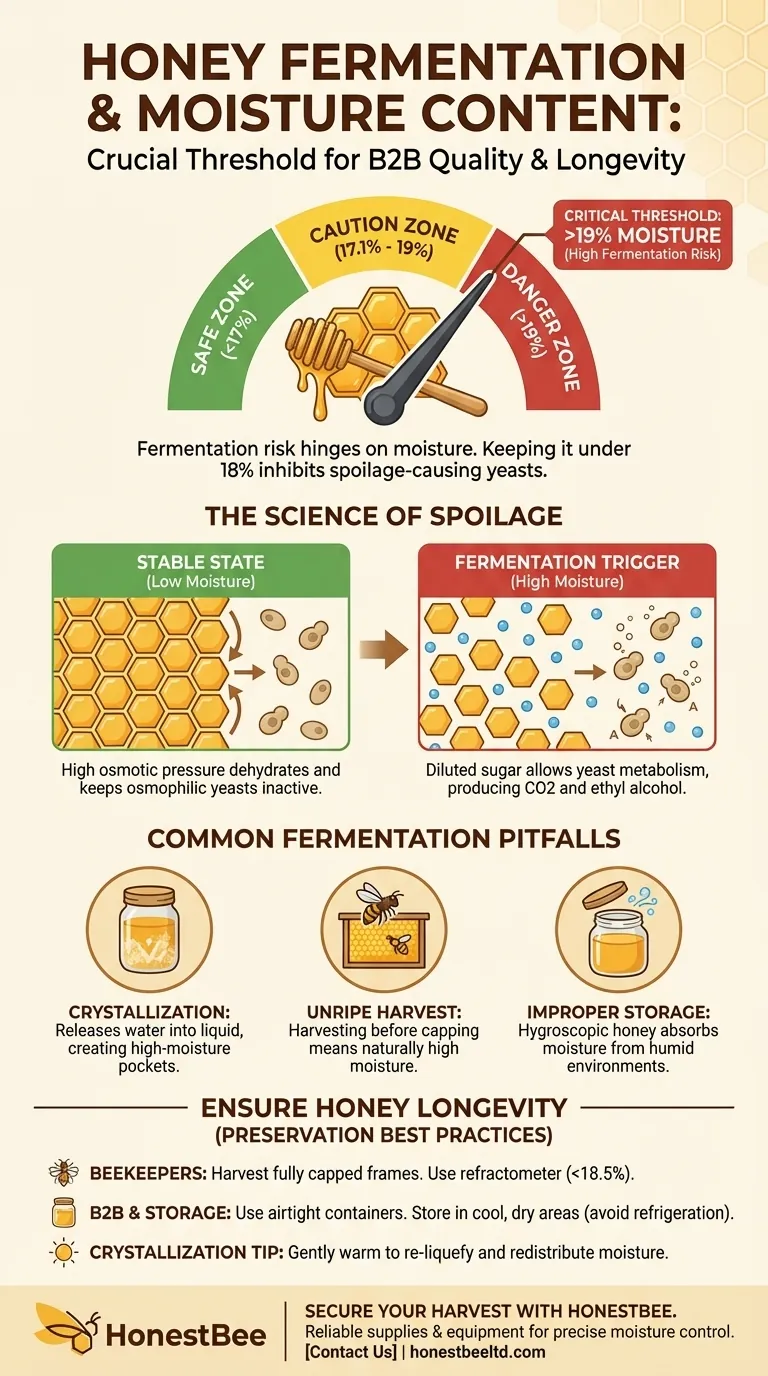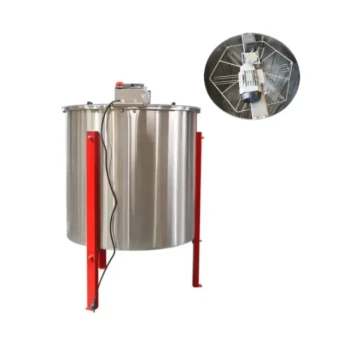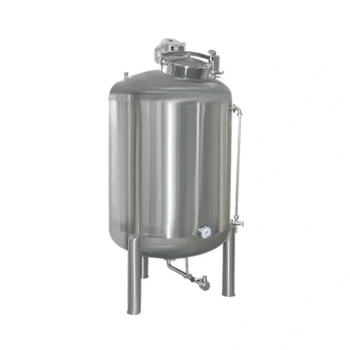Honey's remarkable shelf life is not guaranteed. Its resistance to spoilage hinges directly on its moisture content. Fermentation becomes a significant risk when honey's moisture rises above 19%. While honey with 17% moisture or less is considered extremely stable, the risk increases progressively in the 17% to 19% range.
The critical factor in preventing honey fermentation is controlling its moisture. Keeping the moisture content below 18% effectively inhibits the growth of naturally present yeasts, which are the microorganisms responsible for turning honey sour and alcoholic.

The Science of Honey Preservation
Why Honey Is Naturally Stable
Honey is a supersaturated sugar solution, primarily composed of fructose and glucose. This high sugar concentration and resulting low water activity create a high osmotic pressure.
This environment is hostile to most microorganisms, as it draws water out of their cells, effectively dehydrating and killing them. This is the core reason why properly harvested honey can last for centuries.
The Role of Osmophilic Yeasts
Unlike most microbes, honey contains specific types of dormant, sugar-tolerant yeasts known as osmophilic yeasts.
In honey with low moisture content, these yeasts remain inactive. The high sugar concentration keeps them in a preserved, dormant state.
How Excess Moisture Triggers Fermentation
When the moisture content in honey increases, the sugar solution becomes diluted. This reduces the osmotic pressure.
Once the moisture level crosses a certain threshold, the environment becomes hospitable enough for these osmophilic yeasts to activate. They begin to metabolize the sugars, producing carbon dioxide and ethyl alcohol as byproducts. This process is fermentation.
Understanding the Moisture Content Thresholds
The Safe Zone: Below 17%
Honey with a moisture content of 17% or lower is considered the gold standard for long-term stability. At this level, the risk of fermentation is negligible.
The Caution Zone: 17.1% to 19%
This is a transitional range where the risk of fermentation begins to increase. Other factors, such as the specific yeast count in the honey and storage temperature, can influence whether fermentation will begin.
The Danger Zone: Above 19%
Honey with a moisture content over 19% is highly susceptible to fermentation. The conditions are now favorable for yeast to thrive, and spoilage is not a matter of if, but when. This honey is considered low-quality and unstable.
Common Pitfalls That Increase Fermentation Risk
The Impact of Crystallization
When honey crystallizes or granulates, glucose sugars form solid crystals. This process releases water, which increases the moisture content of the remaining liquid fructose portion.
This creates localized, high-moisture pockets within the honey. Fermentation can begin in these pockets even if the honey's overall moisture content was initially at a safe level.
Harvesting Unripe Honey
Bees naturally dehydrate nectar in the honeycomb, fanning their wings to evaporate water until it reaches the optimal moisture level (typically below 18%).
Harvesting honey before the bees have "capped" the cells with wax often means the honey is unripe and has a naturally high moisture content, making it prone to fermenting quickly.
Improper Storage
Honey is hygroscopic, meaning it can absorb moisture from the surrounding air.
Storing honey in a humid environment or in a container that is not airtight can cause its moisture content to rise over time, eventually pushing it into the danger zone for fermentation.
Making the Right Choice for Preservation
To ensure the longevity of honey, the goal is always to maintain a low moisture content.
- If you are a beekeeper: Prioritize harvesting honey only from fully capped frames and consider using a honey refractometer to verify the moisture content is below 18.5% before extraction.
- If you are a consumer: Store all honey in a tightly sealed, airtight container and keep it in a cool, dry pantry. Avoid refrigeration, as it can accelerate crystallization.
- If your honey crystallizes: Understand that this is a natural process, but it slightly increases fermentation risk over the long term. You can gently warm the jar in a water bath to re-liquefy it and ensure the moisture is evenly distributed.
Ultimately, managing moisture is the single most important factor in preserving the unique quality and integrity of honey.
Summary Table:
| Moisture Level | Fermentation Risk | Status |
|---|---|---|
| Below 17% | Negligible | Safe Zone |
| 17.1% - 19% | Increasing | Caution Zone |
| Above 19% | High | Danger Zone |
Ensure the quality and longevity of your honey harvest with HONESTBEE.
As a commercial apiary or beekeeping equipment distributor, maintaining precise moisture control is critical to preventing fermentation and preserving product value. HONESTBEE supplies reliable beekeeping supplies and equipment, including honey refractometers and airtight storage solutions, to help you monitor and manage honey moisture levels effectively.
Contact us today to explore our wholesale-focused product range and secure the tools you need for superior honey preservation.
Visual Guide

Related Products
- Precision Honey Refractometer Instrument for Quality Assessment
- 0.5T Capacity Honey Dehumidifier Dryer with Vacuum Heating and Thickening Filtering Machine
- HONESTBEE 6 Frame Self Reversing Electric Honey Extractor for Beekeeping
- HONESTBEE 3-Frame Manual Acrylic Honey Extractor
- Plastic Hand Crank 2 Frame Honey Extractor Low Price
People Also Ask
- How does a honey refractometer work? Ensure Honey Quality & Harvest Readiness
- What are the benefits of using a Pocket Digital Honey Refractometer? Achieve Precision & Speed in Honey Quality Control
- What is a honey refractometer? The Essential Tool for Perfect Honey Quality
- Why is a honey refractometer important for beekeepers? Ensure Quality and Prevent Fermentation
- What is a honey refractometer and what is its purpose? Ensure Honey Quality and Prevent Spoilage



















